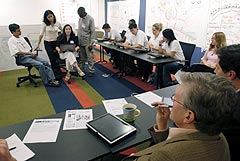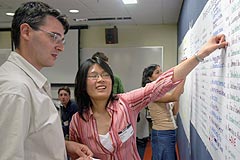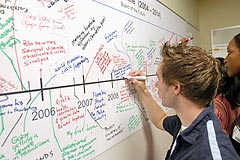
Microsoft Group Vice President Jeff Raikes (front) listens to university students from around the world, June 25, 2004, Redmond, Wash.
REDMOND, Wash., July 6, 2004 — Simon Moss doesn’t know how to live without software. He and his classmates began doing their school work on personal laptop computers since seventh grade. The 21-year-old Australian student now runs a personal business and manages volunteers for a non-profit foundation almost entirely online and via his mobile phone.
Peter Njeru is still discovering the possibilities of software, but he’s a determined explorer. A top student at his secondary school in Nairobi, Kenya, he scraped together the money to get computer lessons. Now 21 and studying architecture, he spends hours each day at a community computer lab doing online research and sending e-mails.
Moss and Njeru are among the 15 college students from around the world who are serving on the inaugural Microsoft Office Information Worker Board of the Future, an advisory panel the company formed to help determine how to better serve their generation — the so-called Internet Generation. The biggest and most technologically literate group of information workers ever, these “NetGeners” are graduating from college and entering the workforce.
“This program is designed to get us to open up our minds,” says Dan Rasmus, director for Information Work Vision in the Information Worker New Markets group at Microsoft. “We really want to get out and broaden our perceptions, look at people who process information differently and are not as influenced by the way products are typically designed at Microsoft.”
The board gathered for the first time June 21-25 on Microsoft’s Redmond campus, and its initial recommendations lived up to Rasmus’ expectations. The board members said they wanted today’s software to be even more mobile, more easily and broadly customized and more accessible to people around the world. What’s needed, the board says, are simplified and streamlined versions of current software. Also needed are increased software training, resources and culturally appropriate user interfaces and hardware to extend the productivity gains of software within developing nations, along with those IT has passed by in the developed world.
“We need to have the technology adapt to the people, not the people adapt to the technology,” says board member yvind Kildal Stangnes, a marketing student from Norway.
Board of the Future Offers Diverse Perspectives
The board’s recommendations represent a true world view, informed by perspectives, interests and experiences as diverse as the 14 different homelands from which the board members hail. By design, there are no future software designers or computer-science students on the board. Instead, there’s a future doctor from India, a lawyer-to-be from South Africa, an engineer-in-training from Turkey and a few budding diplomats and politicians. Several already manage their own businesses, including one who runs a music promotion business while also running for public office in his hometown in the U.S. state of New Jersey.
What unites the board members is a generational understanding and awareness of IT. Moss and others from developed nations have never known a world where information isn’t personal, omnipresent and instant, through the Internet, e-mail, a mobile phone, SMS mobile text messaging or instant messaging.
When Moss reads e-mail or other documents online, he scrolls down the page every second or so, while also keeping track of onscreen alerts for new e-mail and instant messages. Older friends and family members less accustomed to these technologies often take five to 10 seconds to make it through a single page. It’s as if they are passengers, and the technology is directing them, he says.
“We’ve always been drivers,” Moss says. “We’ve had so much experience learning to use technology this way. When you are (a driver), you pick up more (and complete tasks) a lot quicker.”
Nowhere was this more easily visible during the board’s first gathering than with the Acer Tablet PCs that Microsoft gave to each of the students. Less than a day after receiving the devices, most were using the onscreen handwriting feature offered by the Tablet PC and Microsoft Office OneNote as their primary tools for taking notes and working on projects.
As might be expected from “drivers,” the board members say they and other NetGeners prefer to work and play on the go, integrating the two activities throughout their lives. The concept of spending eight hours a day in an office or walled cubicle is as unnecessary and unappealing to them as pounding out a term paper on a manual typewriter.
They say Microsoft needs to expand the ways in which people can access information and interact with IT outside of the traditional office, so they can work wherever and whenever they want to. “We don’t want to work in a box,” board member Stephen Sutton, an honors student of history and law from New Zealand, told senior Microsoft Information Worker executives.
Introducing CARL
Board members applaud the direction Microsoft is taking with its next generation of software, especially the prototype technologies in the Center for Information Work on the Redmond campus. The CIW is a showroom for the office of the future, offering demonstrations of advanced mobile, connected and other technology innovations that Microsoft and its partners are developing for future information workers. Among the conveniences on display are user interfaces that provide smarter scheduling and coordination options, along with a more expansive view of all of a person’s information sources. There are also multi-screen monitors that provide information workers a larger virtual desktop and a “Ringcam” that provides remote attendees a 360-degree view of a meeting room and those in attendance.
The board suggested Microsoft extend some of the concepts they saw in the center and in demonstrations from Microsoft Research (MSR) to create what they called a Creative Artificial Responsive Lifeform, or CARL for short. Similar — but with none of the sinister overtones — to the monotoned assistant Hal in the celebrated film “2001: A Space Odyssey,” CARL would be an omnipresent software aide that takes the complexity out of technology, automatically looking up and providing information and resources and synchronizing all of a person’s devices. The students saw CARL as a metaphor for how they would like to interact with technology, not as an actual suggestion for implementation. They contrasted CARL with Clippy, the onscreen assistant in previous versions of Microsoft Office, suggesting extensions that would make assistance more fluid and less intrusive. CARL could act as a design concept that drives interface design choices and underlying technology investments. Software driven by technology like CARL would respond to voice commands, manage replication of content across devices and learn a person’s preferences, adapting over time to the individual’s work methods and information needs.

Board members Daniele Rosa (left), 23, from Italy, and Tina (Ting-Hui) Lee, 22, from Canada, June 21, 2004, Redmond, Wash.
No strangers to the concept of smart assistants, Microsoft Office System executives applauded the idea and underlying design principles behind CARL. Jeff Raikes, group vice president of the Information Worker Business Group at Microsoft, said Clippy was an effort to begin providing people similar assistance. But turning Clippy into CARL would require software with a level of human intellect that’s not yet possible, he said.
Overcoming Education Deficits, Cultural Barriers to IT
Smart assistants are only part of the solution in developing nations, the board said. Kenyan board member Peter Njeru told the Microsoft Office System executives about bright students in his homeland who have to take jobs as watchmen because they lack software training or resources or can’t relate to technology because it so strongly reflects Western cultural norms.
Microsoft has funded efforts and studied ways to bridge what’s termed the “digital divide” — the gap between world’s technology haves and have-nots. One effort extended Internet connections to 200 public libraries in underserved urban and rural areas of the United States. This pilot program is now being expanded to libraries in every state through a partnership with the Gates Library Initiative. Others efforts are extending software training and resources to underserved areas.
The IW Board of the Future proposed a project that would build on Microsoft’s current efforts and eventually extend them globally. The students asked Microsoft to partner with them in developing a technological and entrepreneurial training program aimed at developing information worker skills in developing economies. Board members offered to help develop the project with Microsoft’s assistance. The IW Board of the Future suggested the program be initially located in South Africa, citing that country’s political willingness to tackle these significant social and economic issues. They see how the program could be adapted for other countries, including Brazil, India, China and Russia.

Oyvind Kildal Stagnes, 24, from Norway, adds his predictions to a timeline of the future, June 21, 2004, Redmond, Wash.
To help overcome the cultural barriers that prevent some people in developing nations from embracing IT, the board proposed an African Tablet PC. The Tablet concept would be essential, they said, because it allows people to create and reuse handwritten notes on the screen of the PC, a concept that is easier to learn and more concrete and personal than typed text or commands. The students’ concept PC would also feature specific cultural icons and other features appropriate to the culture idioms and needs of people in underdeveloped parts of Africa. Similar design principles could be used to create PCs for other regions where the adoption of modern technology is hindered by cultural barriers.
“Africans don’t lack intellectual capacity,” says Anesu Bridget Mhlanga, a law student from South Africa. “What we are asking is that you customize it to best suit the needs of our people.”
The other Microsoft Office System executives took notes on their Tablet PCs throughout the board’s presentation, and Raikes said he looks forward to reviewing their complete proposal for the youth-based training project. He and other Microsoft executives will also seek feedback from the board members to determine next steps for the board.
Raikes challenged the students to keep pushing Microsoft. “Some people would describe you as being idealistic about the world,” he said. “(But) from those great aspirations, people who are passionate and dedicated can go drive change.”




